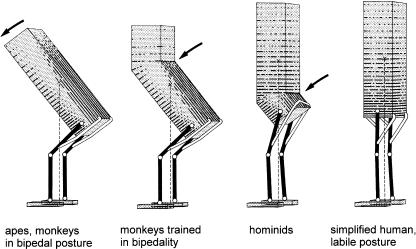Fig. 17.
Schematic variation of trunk shapes to minimize the bending moments along the trunk axis. The dorsal muscles have to exert tensile forces to keep the mobile spine in its position. Left, in semi-upright posture, muscle activity is necessary along the entire trunk; second left, if a lordotic flexion is assumed, the muscle activity can be confined to the part caudal to the flexion; second right, if the flexion is shifted caudally, muscle force can be saved, but this is only possible if the pelvis is short (as in australopithecines); or right, if the pelvis itself is involved in the lordotic curvature (as in Homo). The inclined position of the long axis of the pelvis, from iliac crest to the ischial tuberosity, allows the musculature to remain without great functional change.

